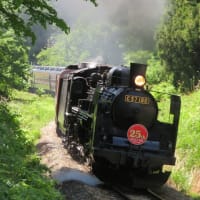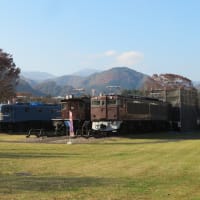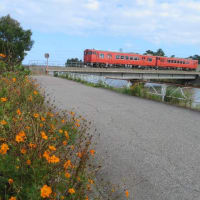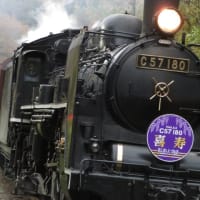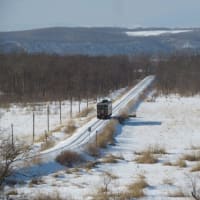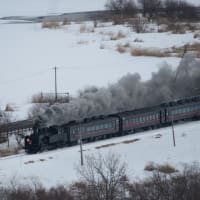
1968年4月15日にモンタナ州から日本向けの小麦輸出のための特別列車「グレイン・スペシャル」が発車したとの新聞記事です。輸入商社は三井物産です。50両のカバードホッパーを連ねて17万5000ブッシェルの小麦をモンタナから西海岸ポートランドまで運びます。グレートノーザン鉄道は、色々なところで日本と絡んでいることを感じさせてくれます。
上の写真は、小生が大好きな「グレインローディング」のかバードホッパーです。小生は特にこのグレーシャーグリーンに「グレインローディング」のロゴ入りのホッパーが大好きです。(このホッパーについては、このブログの2005年6月9日版もご覧ください。)
(新聞記事を長文ですが転載します)
Daily Inter Lake
April 15, 1968
Special Train Leaves Tuesday With Montana Wheat Destined For Japanese Grain Markets
A solid train load of Montana wheat bound for export to Japan will roll out of Wolf Point Tuesday over Great Northern Railway. The 175,000 bushel shipment carried in 50 covered hopper cars is the first such movement by rail from Montana to a Pacific Northwest port. The grain, bound for Portland, Ore., was loaded April 15 from elevators of Peavey Producer Service, Equity Cooperative Association and the Farmers Union Elevator Company. The hoppers, ranging in size from 4,000 to 5,260 cubic feet capacity, average 3,500 bushels each.
Destination is Peavey's West Coast Terminal Operations at Portland. The grain will be unloaded April 18 and 19 and ultimately will be taken aboard ship chartered by the account of Mitsui Trading Co. for shipment to Japan.
The experimental train will be operated to determine the advantages that would accrue to producers and marketers as well as G. N. from the trainload movement of grain in covered hoppers. G. N.'s "grain special" originally was conceived by Ted Schwinden, Wolf Point grain grower, who initiated negotiations between growers, elevator operators and the G. N. The operators held back grain from normal commerce and made improvements to elevators to make the test possible.
The cooperative test is expected to result in valuable information for producer groups and elevator operators enabling them to help solve problems involved in rapidly gathering a large quantity of grain to satisfy export requirements. "Of prime interest to all parties concerned is the importance the American grain industry is giving to the burgeoning grain export market," said A. E. Michon, G. N. market manager, grain and grain products. "The Japanese and Far East markets for American grain are of vital significance to farmers, county elevator operators and the railroads," he added.
A solid grain train could give all parties a logistical control they do not experience in conventional freight movements, Michon said. Maintaining the domestic grain markets and expanding foreign exports could prove beneficial to participating parties.
- The grower would realize the economic benefits of a broadened market for his grain;
- The county elevator operator could experience a fast turnover of a greater volume of grain than is now possible;
- The exporter may be able to purchase larger quantities of grain on a more consistent basis thereby reducing ship and car demurrage charges.
The railroad could realize greater car utilization in moving grain in large volume on a scheduled basis from one consignor to one consignee over an extended period. Burdensome services such as five days free time at the port for unloading, 48 hours free time at origin for loading, stopping cars at interior hold points for sampling and diversion would be minimized.
An observation team accompanying the "special" is comprised of representatives of elevator operators and G. N. marketing officials and operations department specialists. They include Charles Wulff, traffic manager, Farmers Union Grain Terminal Association; James Scoggin, vice president in charge of traffic, Peavey Co., Schwinden, producer; Robert Penner, president of the Citizens First National Bank of Wolf Point and mayor; Clarence Olfert, manager of the Equity Cooperative Elevator, Wolf Point and president of the Northeast Montana Elevator Association.
G. N. officials who will accompany the train are Mal M. Scanlan, vice president marketing; P. F. Cruikshank, assistant vice president, marketing - planning; Michon; M. H. Karl, manager of pricing, grain and grain products; A. M. Einhorn, senior cost analyst, vice president and comptroller's office; John T. Hall, research analyst, marketing department, and J. R. Galassi, trainmaster, division of economic research, executive department.
Advent of hoppers, including the "jumbo" variety, vastly accelerated the loading and unloading of grain. A "jumbo" hopper has the carrying capacity one and one-half standard-sized boxcars. Great Northern first purchased covered hoppers in 1940. The railway currently has 2,799 covered hoppers in its fleet of cars. Their acquisition meant a capital expenditure of $38,063,000 or an average cost of $13,600 per hopper
上の写真は、小生が大好きな「グレインローディング」のかバードホッパーです。小生は特にこのグレーシャーグリーンに「グレインローディング」のロゴ入りのホッパーが大好きです。(このホッパーについては、このブログの2005年6月9日版もご覧ください。)
(新聞記事を長文ですが転載します)
Daily Inter Lake
April 15, 1968
Special Train Leaves Tuesday With Montana Wheat Destined For Japanese Grain Markets
A solid train load of Montana wheat bound for export to Japan will roll out of Wolf Point Tuesday over Great Northern Railway. The 175,000 bushel shipment carried in 50 covered hopper cars is the first such movement by rail from Montana to a Pacific Northwest port. The grain, bound for Portland, Ore., was loaded April 15 from elevators of Peavey Producer Service, Equity Cooperative Association and the Farmers Union Elevator Company. The hoppers, ranging in size from 4,000 to 5,260 cubic feet capacity, average 3,500 bushels each.
Destination is Peavey's West Coast Terminal Operations at Portland. The grain will be unloaded April 18 and 19 and ultimately will be taken aboard ship chartered by the account of Mitsui Trading Co. for shipment to Japan.
The experimental train will be operated to determine the advantages that would accrue to producers and marketers as well as G. N. from the trainload movement of grain in covered hoppers. G. N.'s "grain special" originally was conceived by Ted Schwinden, Wolf Point grain grower, who initiated negotiations between growers, elevator operators and the G. N. The operators held back grain from normal commerce and made improvements to elevators to make the test possible.
The cooperative test is expected to result in valuable information for producer groups and elevator operators enabling them to help solve problems involved in rapidly gathering a large quantity of grain to satisfy export requirements. "Of prime interest to all parties concerned is the importance the American grain industry is giving to the burgeoning grain export market," said A. E. Michon, G. N. market manager, grain and grain products. "The Japanese and Far East markets for American grain are of vital significance to farmers, county elevator operators and the railroads," he added.
A solid grain train could give all parties a logistical control they do not experience in conventional freight movements, Michon said. Maintaining the domestic grain markets and expanding foreign exports could prove beneficial to participating parties.
- The grower would realize the economic benefits of a broadened market for his grain;
- The county elevator operator could experience a fast turnover of a greater volume of grain than is now possible;
- The exporter may be able to purchase larger quantities of grain on a more consistent basis thereby reducing ship and car demurrage charges.
The railroad could realize greater car utilization in moving grain in large volume on a scheduled basis from one consignor to one consignee over an extended period. Burdensome services such as five days free time at the port for unloading, 48 hours free time at origin for loading, stopping cars at interior hold points for sampling and diversion would be minimized.
An observation team accompanying the "special" is comprised of representatives of elevator operators and G. N. marketing officials and operations department specialists. They include Charles Wulff, traffic manager, Farmers Union Grain Terminal Association; James Scoggin, vice president in charge of traffic, Peavey Co., Schwinden, producer; Robert Penner, president of the Citizens First National Bank of Wolf Point and mayor; Clarence Olfert, manager of the Equity Cooperative Elevator, Wolf Point and president of the Northeast Montana Elevator Association.
G. N. officials who will accompany the train are Mal M. Scanlan, vice president marketing; P. F. Cruikshank, assistant vice president, marketing - planning; Michon; M. H. Karl, manager of pricing, grain and grain products; A. M. Einhorn, senior cost analyst, vice president and comptroller's office; John T. Hall, research analyst, marketing department, and J. R. Galassi, trainmaster, division of economic research, executive department.
Advent of hoppers, including the "jumbo" variety, vastly accelerated the loading and unloading of grain. A "jumbo" hopper has the carrying capacity one and one-half standard-sized boxcars. Great Northern first purchased covered hoppers in 1940. The railway currently has 2,799 covered hoppers in its fleet of cars. Their acquisition meant a capital expenditure of $38,063,000 or an average cost of $13,600 per hopper











